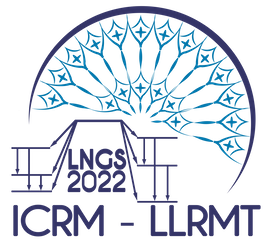Speaker
Description
Among various recently developed compounds from the A2MB6-family (A = Li, K, Cs, Tl; M = Hf or Zr; B = Cl, Br or I), the Cs2ZrCl6 (CZC) scintillating crystals are of particular interest as they are the first scintillating material containing 16% Zr by weight. The 96Zr isotope is a very promising for neutrinoless double beta decay (DBD) searches because of its high energy transition (Qbb = 3.35 MeV) that naturally helps to overcome issues with background events from environmental gamma radioactivity (up to 2.6 MeV) and internal beta-active 214Bi nuclide from the 238U decay chain (up to 3.27 MeV), thus significantly reducing requirements for the detector material radiopurity. The high transition energy is also favorable from a theoretical point of view, since the expected half-life for the neutrinoless mode of DBD is proportional to (Qbb)5. Thus half-life estimations are on the level of 1024 years for 96Zr, which is significantly lower than for any of the commonly used DBD isotopes.
In this work, we present the first complex study of CZC scintillating crystals in terms of their chemical purity and segregation effect of impurity elements along the crystalline boule, their radiopurity, scintillating performance and pulse-shape discrimination capability. A ICP-MS measurement exhibits a high purity of the material (overall impurity level less than 10 ppm) and that elements such as Tl, Th and U are concentrated mainly in the nose of the crystalline boule, while elements such as Pb, Bi and Hf tend to be concentrated in the tail. The internal gamma-background of CZC crystals was investigated using a HPGe detector, and showed a very low content of U/Th natural decay chains, 40K and 137Cs isotopes, only limits at the level of few mBq kg-1 could be set after more than 650 hours of measurement. Nevertheless, they contained 134Cs cosmogenic radionuclide with activity at the level of 50 mBq kg-1. The measurement of two CZC crystals (30 g) as a scintillating detector performed over 1900 hours in a low-background DAMA R&D facility located deep underground at LNGS confirmed a high radiopurity of these crystals leading to a counting rate of 0.014 counts (kg keV y)-1 at Qbb. The energy resolution FWHM = 6.1% was achieved with 662 keV gammas of 137Cs along with a high particle-discrimination ability with FOM = 4.5 for a CZC (diam.21×21 mm) sample. Moreover, we are presenting the study of CZC scintillation properties in the 12-300 K temperature range that revealed a tangible enhancement of a scintillation yield in the 125-150 K interval. A detailed analysis of the internal background components along with a wide temperature range scintillating properties study will be useful for a further development of Cs2ZrCl6-based low-background scintillating detector and optimization of experimental conditions aiming to achieve the excellent energy resolution and pulse-shape discrimination.

